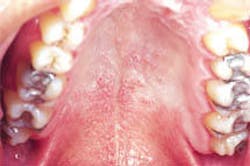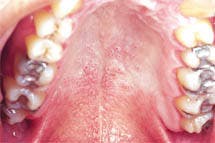Case Study
A 55-year-old male visited a dental office for a checkup. Multiple, tiny papules were noted during the oral exam.
History
The patient was questioned about the presence of the multiple papules on his posterior hard palate. The patient claimed that he was unaware of the affected area. He remarked that the area was not painful and denied any history of trauma or thermal injury. When questioned concerning social history, the patient admitted to a 12-year history of pipe-smoking.
The patient's past dental history included routine examinations and restorative treatment. At the time of the dental appointment, the patient appeared to be in a general good state of health.
Examinations
Examination of the head and neck region revealed no palpable lymph nodes. All vital signs were found to be within normal limits. Oral examination revealed multiple, tiny, and flat-topped white papules on the posterior hard palate (see photo).
Each papule exhibited a central, tiny red dot surrounded by a white keratotic ring. The papules could not be removed by wiping or scraping. The adjacent mucosal surface of the soft palate appeared wrinkled and fissured. Further examination of the oral cavity revealed no other lesions present.
Clinical diagnosis
Based on the clinical information presented, which of the following is the most likely diagnosis?
- inflammatory papillary hyperplasia
- proliferative verrucous leukoplakia
- hyperplastic candidiasis
- nicotine stomatitis
- white sponge nevus
Diagnosis
Nicotine stomatitis
Discussion
Nicotine stomatitis, also known as nicotine palatinus or smoker's palate, is a condition of the palatal mucosa that is seen in response to the heat produced by smoking a pipe or cigar. Because pipe-smoking generates more heat on the palate than other forms of smoking, nicotine stomatitis has historically been associated with this habit.
Similar changes of the palate also have been linked to the long-term use of extremely hot beverages. Although this lesion is associated with tobacco use, it is not associated with malignant mucosal changes, supporting the theory that it is caused by heat and not the chemicals in tobacco smoke.
Clinical features
Nicotine stomatitis typically affects males over the age of 45. This lesion is found on the palatal mucosa and has a very characteristic clinical appearance. Initially, the condition appears as a red area of the palatal mucosa. With time, the reddish area progresses on to become a diffuse, keratotic white area. The whitish area may exhibit a wrinkled or fissured appearance.
Multiple, tiny, and flat-topped papules with red, depressed centers are seen scattered over the keratotic portions of the posterior hard palate and adjacent soft palate. The tiny papules form due to the cystic dilation and enlargement of minor salivary glands found in the palatal region, and the red dots represent the inflamed orifices of the minor salivary glands.
Diagnosis and treatment
The diagnosis of nicotine stomatitis is made on a clinical basis. The presence of scattered white papules with red, depressed centers located on the palatal mucosa of a pipe or cigar smoker is considered characteristic and sufficient to establish the diagnosis.
Nicotine stomatitis is a reversible lesion, even in cases of a prolonged duration. The mucosa of the palate returns to a normal appearance approximately one to two weeks following the cessation of the cigar or pipe-smoking. Any persistent white area of the palatal mucosa that does not return to normal after one month must be biopsied for a definitive diagnosis. Patients with nicotine stomatitis should be encouraged to stop smoking. In addition, other high-risk areas of the oral cavity should be carefully examined for tobacco-related changes indicative of dysplasia.
Joen Iannucci Haring, DDS, MS, is an associate professor of clinical dentistry, Section of Primary Care, The Ohio State University College of Dentistry.

